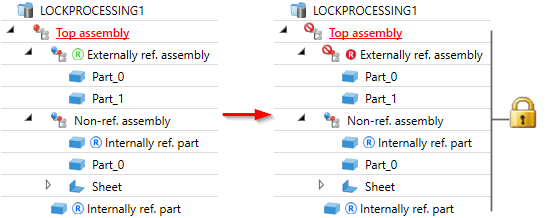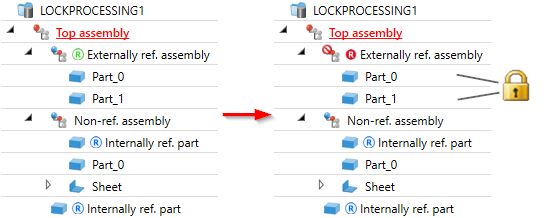Lock Parts Against Processing
Lock against processing
Parts and assemblies of a drawing can be locked against processing. This can be useful, for example, to protect an adjacent structure from unintentional processing.
Please note:
Locking against processing is (mainly) intended for users who do not use HELiOS. If more functionality is desired, then we recommend the use of the PDM system HELiOS.
The HELiOS locking mechanism is prioritised in any case. This means that even if a part is "unlocked" in HiCAD, which is locked in HELiOS, cannot be edited.
The HiCAD functions for locking and unlocking against processing can be found in the context menu for parts and there underLock against processing.
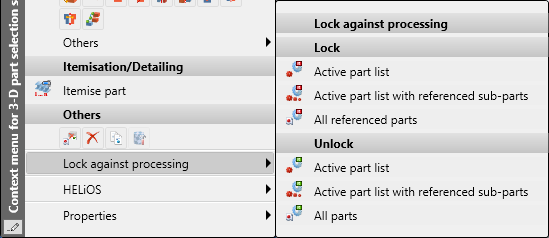
For parts that are locked against processing, all operations that would change the part are blocked. This concerns geometrical changes as well as positional changes of sub-parts and changes to attributes ( depending on the attribute setting). In these cases, a message appears indicating the locked part, e.g.
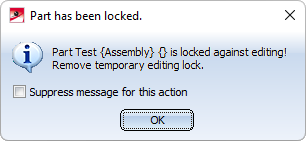
In addition, the locked part will be highlighted in colour in the drawing.
|
Function |
Description |
|---|---|
|
|
Lock, Only active part The active part and all sub-parts that are not externally referenced are locked. Externally referenced sub-parts will not be locked. In this way, it is possible to lock the location of a referenced part in the superordinate assembly, but still allow the geometry to be processed. The active part will be marked in the ICN with a locking symbol. Example:
The Top assembly is locked for processing. The Externally ref. assembly is not locked, i.e. the parts subordinate to this assembly can be processed. All other parts are locked, but are not marked in the ICN. |
|
|
Lock, Active part list with ref- sub-parts The active part is locked - including all sub-parts. Their identical parts are also locked. The active part, all subordinate externally referenced parts as well as their identical parts are marked in the ICN with a locking symbol If a part list (multiple selection) is active when the function is called, this applies to all parts in the part list. Example:
The Top assembly is locked for processing. The Externally ref. assembly is also locked here as well as all other parts. |
|
|
Lock, All referenced parts All externally referenced parts in the drawing are locked. If the part for which the function is called is not referenced, it will not be locked. Internally referenced parts will also not be locked. All externally referenced parts are marked in the ICN with a locking symbol Example:
The Top assembly is locked for processing. Only the Externally ref. assembly is locked here, i.e. the parts subordinate to it. |
|
|
Unlock, Only active part The active part is unlocked. The sub-parts are also unlocked unless they are externally or internally referenced parts that were locked independently of the superordinate part. This applies analogously to identical parts. |
|
|
Unlock, Active part with ref- sub-parts The active part and all sub-parts - including externally referenced ones - are unlocked. |
|
|
Unlock, All parts All parts in the drawing are unlocked - regardless of whether they are referenced or not. |
A part that has already been processed, but has not been saved yet (identified by an  ) cannot be locked. An appropriate message will be issued in such cases.
) cannot be locked. An appropriate message will be issued in such cases.
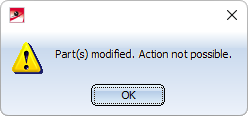
![]() Please note:
Please note:
- The function has been primarily designed for users who do not use HELiOS. If additional functionality is requested, however, we recommend using the PDM system HELiOS.
- The HELiOS locking mechanisms will have priority in any case. This means that even an "unlocked" part that has been released in HELiOS, cannot be processed.
- In (very rare) cases in which a function will not prevent the processing of locked parts, a warning message will be displayed, telling you that you have processed referenced parts for which you have no write permissions due to the lock. In such cases HiCAD will attempt to revert your changes automatically. This is, however, only possible if the KRA file exists. In any case an appropriate message will be displayed, telling you whether the reverting of the changes was successful or not:


- When referencing, we always point out not to use internally referenced parts in an externally referenced assembly. If this is nevertheless the case and identical parts of an internally referenced part are located both below a locked assembly and outside of it, changes to the internally referenced part located outside of it will also be applied to the identical part in the locked assembly. No further message will appear here!
- If you move your mouse over the locking symbol, a corresponding message appears:

- Also observe the notes on locking parts for Plant Engineering functions.

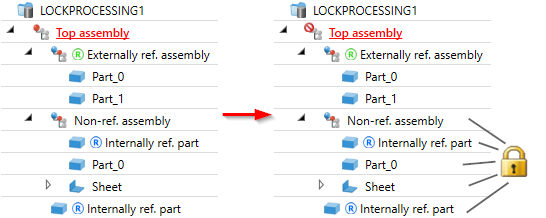

 , externally referenced parts additionally with
, externally referenced parts additionally with  .
.